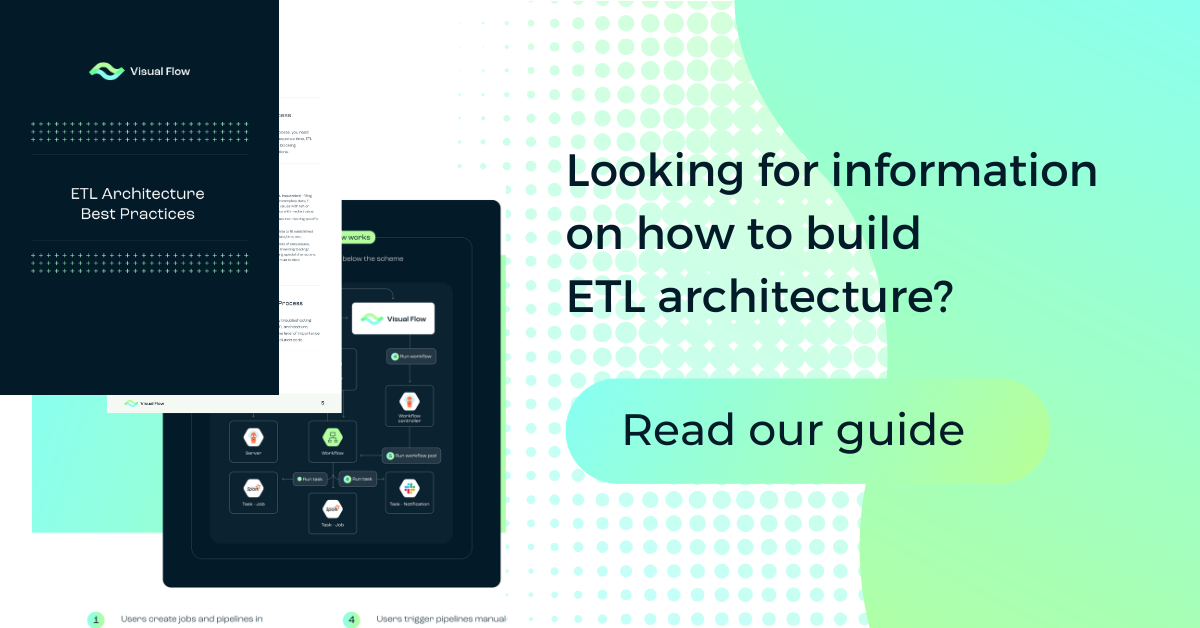Table of Content:
Table of Content:


ETL testing stands for Extract, Transform, Load testing. It is a process used to ensure that data is correctly transferred from various source systems to a target system, usually a data warehouse.
What is ETL Testing?
To understand ETL testing meaning better, it’s important to break down its three main components:
- Extract. This stage involves extracting data from different source systems, such as databases, spreadsheets, or web services. All the necessary data that will be used in the subsequent stages should be pulled.
- Transform. In this phase, the extracted data is transformed according to specific business rules and requirements (cleaning the data, filtering out unnecessary information, aggregating data points, or converting data types). As a result, the data fits the format and structure needed for analysis and reporting.
- Load. The transformed data is loaded into the target system, often a data warehouse or another type of data repository. It becomes available for end-users to access, analyze, and use.
ETL testing means ensuring that data extraction is complete and accurate, data transformations are correctly applied based on the business rules, and that loaded data matches the expected outcome in the target system.

When is ETL Testing Necessary and How is it Done?
ETL testing is necessary for data transfers between systems, particularly in scenarios where complex data transformations and large data volumes are involved:
- Data migration. ETL testing is used to ensure that all data is transferred accurately without any loss or corruption during data migration from legacy systems to new systems.
- Data integration. Combining data from multiple sources into a single repository requires validation to confirm that all data sources are correctly integrated and harmonized.
- Data warehousing. Creating or updating data warehouses necessitates the testing of numerous ETL processes to assure the integrity of the data warehouse.
- System upgrades. Testing ETL processes ensures that upgraded databases or other critical systems handle data properly and keep data integrity intact.
- Regulatory compliance. ETL testing helps industries maintain strict data handling standards by verifying the accuracy, consistency, and completeness of the data.
Validation of data at different stages of the ETL pipeline is achieved through several key steps in the ETL testing process:
- Requirement analysis — determining the business requirements and data transformation rules.
- Test planning — creating a comprehensive test plan outlining the approach, resources, schedule, and test cases for each stage of the ETL process.
- Test environment setup — configuring a testing environment that mirrors the production setting, including source systems, staging areas, and target systems.
- Extract phase testing — verifying that data is correctly extracted from source systems.
- Transform phase testing — validating that data transformations are applied correctly according to business rules, including cleaning, filtering, aggregations, and calculations.
- Load phase testing — ensuring that transformed data is accurately loaded into the target system.
- Performance testing — testing the performance of the ETL process to ensure it can handle expected data volumes within acceptable time frames.
- Regression testing — conducting regression testing to ensure new changes do not adversely affect existing ETL processes.
- Defect reporting and resolution — identifying and documenting any defects found during testing, working with development teams to resolve them, and re-testing as necessary.
- Final validation and sign-off — performing a final validation to ensure all test cases are passed and data integrity is maintained.
Robust and reliable ETL processes deliver accurate and consistent data — this is what organizations receive due to testing ETL processes. If you want to learn even more insights on the role of ETL in business intelligence, check out this detailed article in our blog.

Why is the Quality of Data so Important?
Let’s break down why the quality of data matters:
- When businesses receive high-quality data, they can make well-informed decisions. On the flip side, poor data quality leads to incorrect analyses, flawed strategies, and missed opportunities.
- Many industries have strict regulations about data accuracy and handling. Take financial institutions, for example. They must comply with regulations like GDPR or Sarbanes-Oxley. High-quality data helps them avoid legal issues and costly penalties.
- Accurate data allows businesses to better understand their customers — what they like, how they behave, and what they need. Poor data quality, however, results in misunderstandings and a diminished customer experience.
- High-quality data reduces errors and inefficiencies in operations. Conversely, poor data quality leads to operational hiccups and increased expenses due to errors and rework.
- High-quality data helps organizations identify market trends, optimize processes, and innovate faster than their competitors.
- Quality data helps identify and mitigate risks and potential issues. Poor data quality, however, masks these risks, leading to unforeseen problems and crises.
- Good data quality directly impacts a company’s financial health. Accurate financial data ensures proper budgeting, forecasting, and planning. Inaccurate financial data, on the other hand, leads to losses and poor financial management.
- Quality data fuels product development. Companies can analyze accurate market and customer data to define gaps and create new products or services. Inaccurate data misguides development efforts and results in products that don’t meet market needs.
In short, high data quality is the core of effective business intelligence and organizational success.
What are the Challenges of ETL Testing?
Of course, ETL testing guarantees data accuracy and reliability, but it’s impossible to avoid challenges. However, if you understand them, you can better prepare and implement effective solutions. We’ve gathered some common challenges associated with the ETL testing process to help you. But before we start, let’s explore the types of ETL testing.

Types of ETL Testing
The types of ETL testing are:
- Data completeness testing. Ensures that all expected data is loaded into the target system without any loss.
- Data quality testing. Verifies the accuracy and integrity of the data. It checks for issues such as duplicates, null values, and data format inconsistencies.
- Data transformation testing. Validates that data transformations are applied correctly and meet the expected output.
- ETL regression testing. Checks that new changes or updates to the ETL process have not adversely affected existing functionality.
- Reference data testing. Guarantees that reference data, such as lookup tables, is accurately updated and used during ETL processes.
- Incremental ETL testing. Tests the ETL process for incremental data loads, so that only new or modified data is extracted, transformed, and loaded without duplicating existing records.
- ETL integration testing. Verifies that the ETL process integrates with other systems and processes and that data flows correctly between different components of the architecture.
- ETL performance testing. Checks that ETL jobs are completed within acceptable timeframes and can handle large volumes of data.
Now, let’s move on to the challenges related to each type of ETL testing.

Data Completeness Testing
- Volume of data. Handling and comparing large datasets is sometimes resource-intensive and time-consuming.
- Disparities in source systems. Different formats and structures across various source systems complicate completeness checks.
- Data latency. Differences in data capture timing between source and target systems can lead to false discrepancies.
- Automating the process. Developing scripts to automate the extraction and comparison process requires technical expertise.
- Handling incremental loads. Ensuring completeness during incremental data loads is challenging as it’s easy to miss updates.
Data Quality Testing
- Identifying quality issues. Detecting subtle data quality problems like minor discrepancies or formatting errors may be tricky.
- Automating quality checks. Building automated scripts to continuously monitor data quality requires expertise and ongoing maintenance.
- Handling large volumes of data. Validating data quality across large datasets is resource-intensive.
- Dynamic data sources. Data sources may change over time and lead to new data quality issues.
- Ensuring real-time quality. Maintaining data quality in real-time ETL processes is also challenging.
Data Transformation Testing
- Complex business logic. Testing intricate transformation rules demands an in-depth understanding of business requirements.
- Maintaining test cases. As business rules change, keeping transformation test cases up-to-date is sometimes labor-intensive.
- Managing large volumes of data. Validating transformations across large datasets may be resource-intensive.
- Guaranteeing consistency. Ensuring that transformations produce consistent results across different datasets and conditions may be complicated.
- Automating transformation tests. Building automated scripts to validate complex transformations requires technical expertise.
ETL Regression Testing
- Extensive test suites. Regression testing requires a lot of time-consuming and resource-intensive test cases.
- Keeping track of changes. Ensuring all changes are reflected in your test cases may be tricky.
- Resource constraints. Running comprehensive tests can stress your resources.
- Complex automation. Automating complex ETL processes requires technical know-how.
- Ensuring coverage. Making sure you’ve covered all possible scenarios and edge cases is also challenging sometimes.
Reference Data Testing
- Consistency across systems. Ensuring that reference data is consistent across multiple systems may be tough.
- Frequent updates. Reference data often changes and requires constant monitoring and validation.
- Handling large datasets. Validating large sets of reference data is often resource-intensive.
- Data quality issues. Poor quality reference data leads to incorrect processing and analysis.
Incremental ETL Testing
- Complex logic. Sometimes, figuring out what constitutes a change may be tricky.
- Data consistency. Ensuring the old data stays intact while applying new changes can also be tough.
- Large datasets. Processing big data sets incrementally can strain resources.
- Automation. Automating these tests can be complex but worthwhile.
ETL Integration Testing
- Complex data relationships. Sometimes, it’s difficult to understand and map complex relationships between datasets.
- Data quality issues. Poor quality data from one source can affect the entire integration.
- Handling large volumes. Integrating large datasets can be resource-intensive.
- Managing different formats. Data from various sources often comes in different formats.
ETL Performance Testing
- Complex transformations. They may consume time and require more resources.
- Large data volumes. Managing large volumes of data also strains system resources sometimes.
- System bottlenecks. Identifying and resolving bottlenecks can be complicated.
- Resource constraints. Limited CPU, memory, or storage impact performance.
Now that you know about possible ETL testing challenges, you should find out how to avoid them and perform everything brilliantly. We’ve prepared some best practices for ETL testing.

Recommended Practices for ETL Testing
These tips will help you perform reliable and error-free ETL testing.
- Know what you need. Contact stakeholders to define their needs and expectations. Document all test cases, including expected outcomes and acceptance criteria.
- Plan your testing. Decide what you’ll test — like data transformations or loading — and what you won’t. Include different types of tests, such as unit tests, integration tests, and performance tests. Use realistic data that covers all scenarios.
- Automate where you can. Tools like Apache Nifi, Talend, or Informatica can take care of repetitive tasks. Implement automated regression tests to ensure new changes don’t break existing functionality.
- Keep data quality high. Define and apply validation rules to check data accuracy, completeness, and consistency. Understand your data quality and distribution before and after ETL processes.
- Check data mapping. Make sure data is mapped correctly from source to target. Verify that any calculations, joins, or aggregations are properly applied.
- Test incremental loads. Test both initial full loads and subsequent incremental loads to cover all scenarios. Ensure CDC (Change Data Capture) mechanisms accurately identify and process data changes.
- Monitor performance. Establish performance benchmarks for ETL processes and monitor them. Test to ensure your ETL can manage peak volumes. Monitor resource utilization (CPU, memory, storage) during ETL runs to spot bottlenecks.
- Validate end-to-end. Test the whole ETL flow from extraction to the final load and involve end-users.
- Document everything. Keep records of all test cases, inputs, results, and any issues. Track all issues until they’re resolved.
- Regularly review and update test cases based on changes in requirements or data sources. Use version control for managing changes in ETL scripts and test cases.
- Collaborate across teams. Work closely with data engineers, developers, business analysts, and QA teams. Ensure issues found during testing are quickly communicated to the development team.
And that’s it — you know how to build a robust ETL testing framework. But sometimes, managing ETL testing and migrations is difficult, especially within complex data environments. If you find yourself needing expert assistance, our ETL migration consulting services are just what you need.
Who Should be in Charge of ETL Testing?
Who should be in charge of ETL testing? Great question. Here’s a list of who should be involved:
- ETL developers. They create and maintain the ETL scripts, manage data transformations, and ensure data is correctly loaded into the target systems.
- Quality assurance (QA) engineers. QA engineers guarantee that the ETL processes meet the defined requirements and quality standards. They develop detailed test cases, execute tests, and report any defects or issues.
- Data analysts/business analysts. These experts provide insight into the business requirements and data usage. They validate that the data transformations and loads meet business needs and ensure data accuracy from a user perspective.
- Database administrators (DBAs). DBAs manage and optimize the databases involved in the ETL process. They ensure that the databases are configured correctly, perform well, and securely store the data.
- Project managers. They oversee the entire ETL project lifecycle, coordinate efforts between different teams, manage timelines, and ensure the project stays on track.
- End users. The actual users of the data, often business stakeholders, participate in user acceptance testing (UAT) to validate that the data is delivered as expected.
ETL testing should be a team effort. Each role brings a unique view of how testing covers technical, functional, and business aspects. Collaboration speeds up the testing process and catches more possible errors.

What Does the Future Hold for ETL Testing?
The future of ETL testing is quite exciting, as these trends and developments will shape it:
- Automation and AI integration. Automation tools will become more intelligent due to using AI and machine learning to identify patterns, predict errors, and suggest optimizations without human intervention.
- DataOps and continuous testing. DataOps will streamline ETL testing, which will be integrated into continuous integration/continuous deployment (CI/CD) pipelines for continuous and automated testing throughout the ETL lifecycle.
- Cloud-based ETL solutions. They will manage large data volumes and complex transformations with no need for expensive on-premise infrastructure.
- Enhanced data privacy and security testing. As data privacy regulations become stricter (e.g., GDPR, CCPA), ETL testing will need to include rigorous checks for compliance. Testing will focus more on ensuring data security, including encryption, masking, and secure data flow between systems.
- Integration with big data and advanced analytics. ETL testing will increasingly involve big data platforms like Hadoop and Spark and require new skills and testing approaches.
- Visualization and reporting tools. Advanced visualization tools will help testers and stakeholders better understand ETL process outcomes and identify issues faster.
The future of ETL testing will require adapting to new technologies and methodologies to help your ETL processes stay robust, secure, and scalable.

Final Thoughts
ETL testing faces challenges sometimes, but they’re easy to overcome. Just use our tips and don’t hesitate to ask for Visual Flow’s advice if your ETL processes seem impossible to manage.
Contact us































































